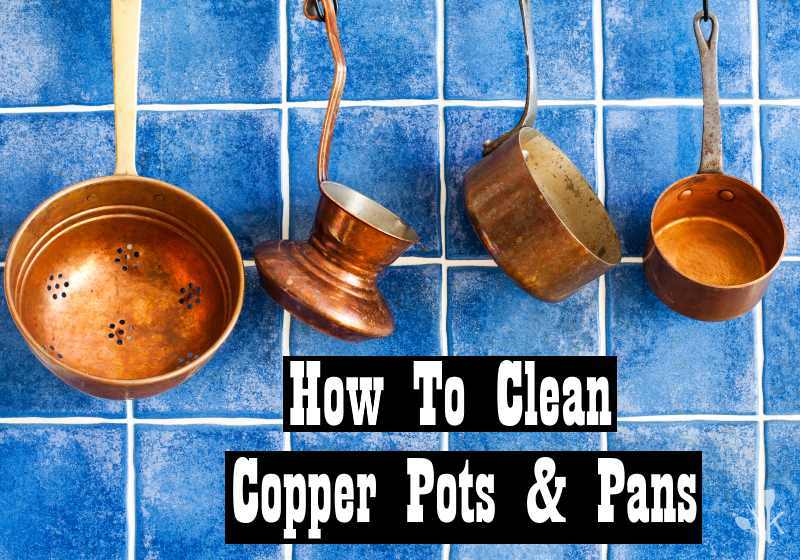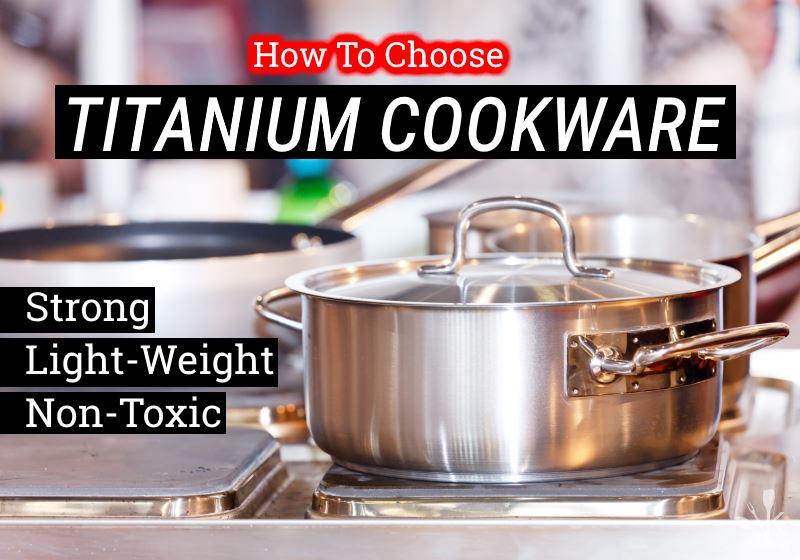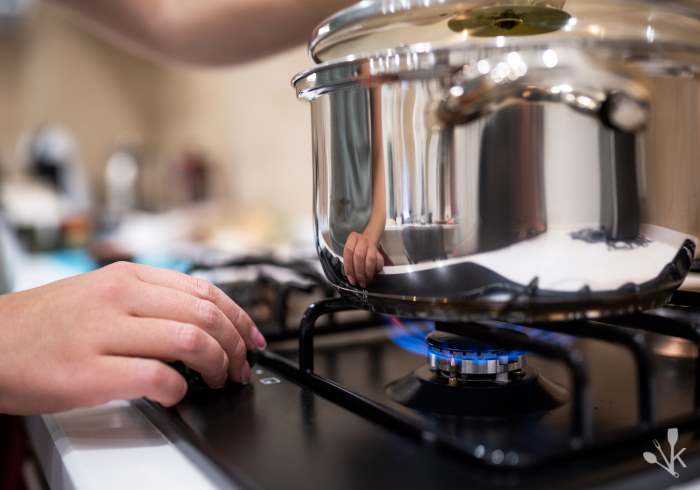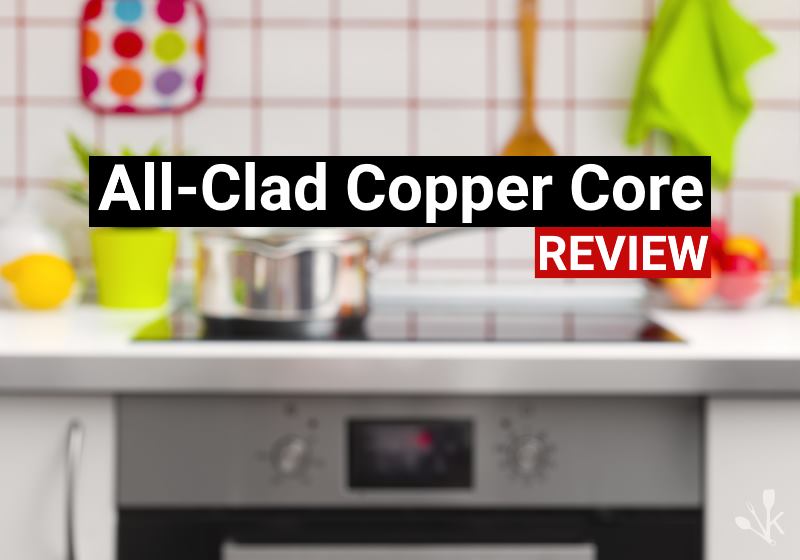Copper has long been a popular metal for cooking pots. Thanks to the ease with which this metal conducts heat, copper-bottomed pots are highly dependable and generally free of hot spots.
Also, copper pots and pans are lightweight in comparison to other traditional cooking pots, such as cast iron.

Unfortunately, copper pots are easily scratched and bent. Copper is also highly reactive to some foods, so it often has to be constructed with a stainless steel lining.
Over time, whether you use them or not, your copper pots will oxidize and grown dull. They’ll need regular attention if you want to enjoy the traditional glow of copper.
Copper Cleaning Products
If the pan is extremely stained or corroded, you may need to invest in some stronger products.
Take care to use scrubbing products that will break down under pressure when cleaning copper pans, or the metal may be scratched in the cleaning process.
Bar Keepers Friend offers a soft cleanser with a gentle abrasive that will buff away stains and tarnish. Be certain to use the non-bleach formula when treating your copper.
Related | Bar Keepers Friend Uses
Once your copper is cleaned, and the tarnish has been removed, consider adding a protective coating to the piece.
Some of the best copper polish available is Wright’s Copper Cream. This product is effective on copper pieces from cooking pots to jewelry and will give your copper pieces a beautiful glow.
How To Clean Copper Cookware
Lemon and Salt
For cleaning copper pots, start with simple products. For example, cutting a lemon in half, dipping the lemon flesh in salt, and using the lemon half as a scrubber to apply the acid and salt.
The grit of the salt will break down when exposed to the lemon juice, so you don’t need to worry about scarring your copper.
For very stubborn stains or a heavy coat of tarnish, you can make a paste of the juice of one lemon and salt and coat the area for 30 minutes, scrubbing occasionally.
Once scrubbing is done, rinse, dry and buff your copper pot.
It should be noted that some copper pieces are lacquered in production. Acid should not be applied to this lacquered finish. If your copper pots are always shiny no matter how long it’s been since you polished them, they’re likely lacquered.
Corrosion Vs. Stains
Vinegar and Salt
Acid will eat away at corrosion or tarnish, but burned on food will stain your copper pots.
As bottoms are visible when you hang your pots, it’s good to study stain removal as well as how to remove tarnish from copper.
Vinegar is another of the copper cleaning products you might have right there in the cupboard.
Cleaning experts with The Huffington Post suggest a combination of scrubbing pads and salt, with a splash of vinegar, to remove stains and corrosion from your copper pots.
- Place the pan in the sink and cover the area to be scrubbed with salt.
- Splash vinegar over this coating of salt.
- Let the vinegar sit for 15 seconds, then add vinegar to your scrubbing sponge and get to work.
While steel wool will scratch copper, a soft plastic scrubbing pad will not be hard enough to impact the surface of the copper.
Use liberal amounts of both vinegar and salt on all surfaces of the copper pot. This should prove effective in scrubbing away stains and in removing corrosion to bring back the warm copper glow of the pot.
Once the pot has been rinsed and dried, you can buff out the surface with a soft cloth to get it to shine.
Joe Truini with Simple Solutions suggests adding a little heat to boost the power of your vinegar.
His video suggests heating the vinegar and salt, letting the copper portion of a copper clad pan soak in this combination for ten minutes, then scrubbing away with extra salt on your sponge.
How To Polish Copper Cookware
If you love cooking with copper, you’ll have to get used to polishing copper. Copper cookware with a lacquered coating will have to have the lacquer stripped before you can cook with it.
For this purpose, experts with Copperton Lane Antiques suggest a bath of baking soda and boiling water. Once the lacquer is removed, the copper is vulnerable to tarnish.
Wright’s Copper Polish, noted above, is a great option to clean up your copper pots. This product will protect as well as polish and remove tarnish. Wright’s also offers a copper polishing cloth.
- For basic cleanup, be sure to wash your copper pot gently in an empty sink with warm, soapy water.
- Rinse it carefully and dry it immediately.
- Once it’s dry, take a sturdy kitchen towel and buff the copper surface to give it a beautiful shine.
It’s important to note that there are several polishing cloths on the market for many different metals.
As a general rule, these cloths are infused with a chemical specific to the removal of tarnish for that metal.
It is extremely important that you use a copper cloth for polishing copper.
Not only can some chemicals harm the existing finish on your copper, but if you plan to cook in these pots, there are chemicals that can brighten other metals that should not be used around heat or near food.
How To Care For Copper Cookware
One of the simplest ways to care for your copper pots is to hang them from a position where they won’t come in contact with other metal.
As previously stated, copper can be easily bumped, scratched and dinged. Storing your copper pots carefully will reduce the risk of a permanent scar.
Any time you use your copper cookware, be certain to handwash it in a sink alone. If you settle it into a sink of dirty dishes, it may get bumped against tools of harder metals and get a scratch or a ding.
Cleaning copper needn’t be onerous. Simple acids such as lemon juice and vinegar with salt as an abrasive can remove a great deal of tarnish, and some elbow grease can get rid of a lot of stains.
There are also many products on the market dedicated to cleaning and protecting copper.
Final Thoughts
Copper is an excellent metal for conducting heat and is naturally antimicrobial. However, it will tarnish and corrode over time.
To keep your copper glowing with warmth and beauty, hang it to avoid bumps and scratches.
Wash, dry and buff the pot each time you use it. If you notice the copper getting dull, use the lemon and salt or vinegar and salt scrub to remove tarnish.
Finally, wipe the pan with a protective copper polishing cream and buff the pan thoroughly.











